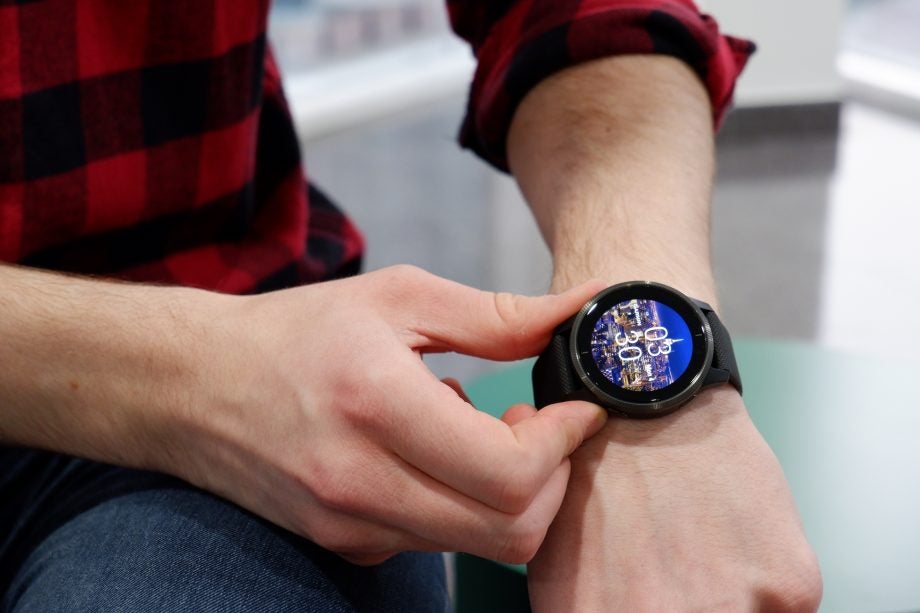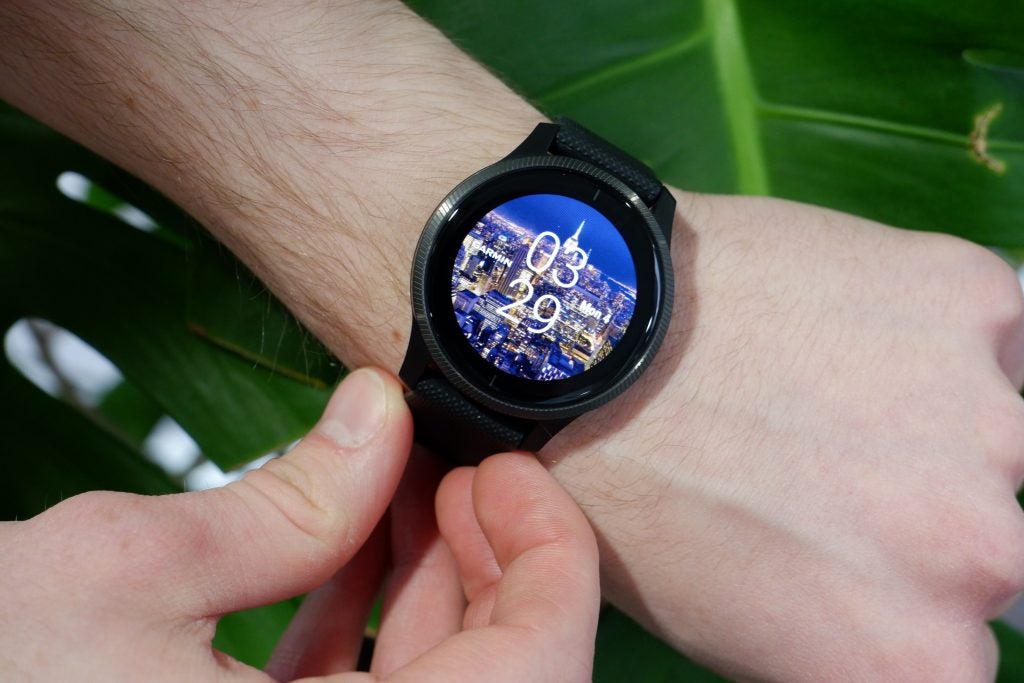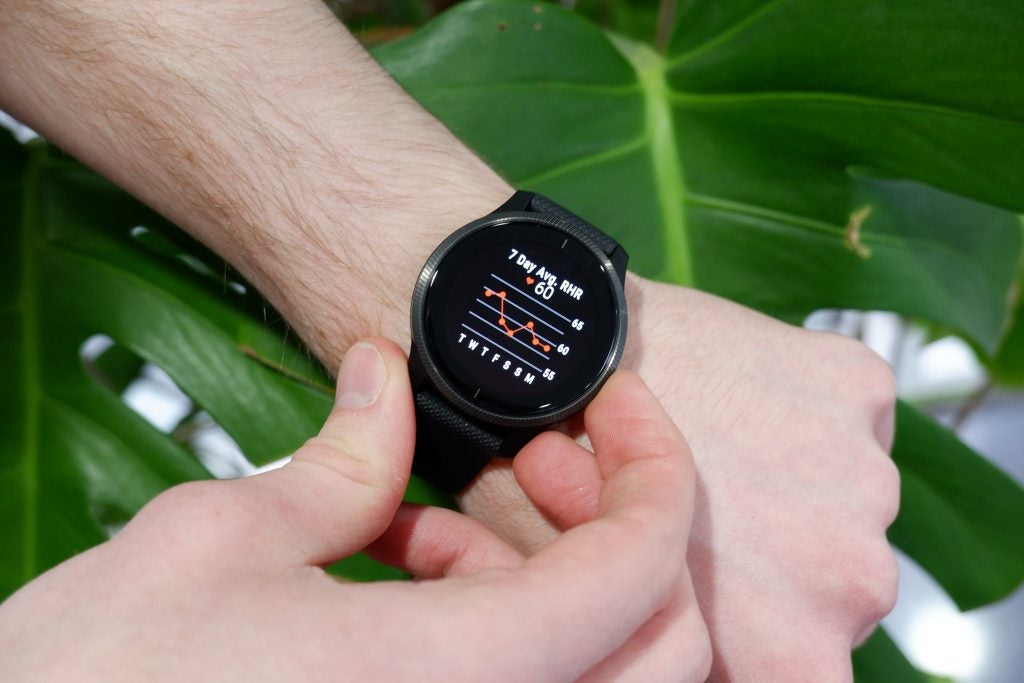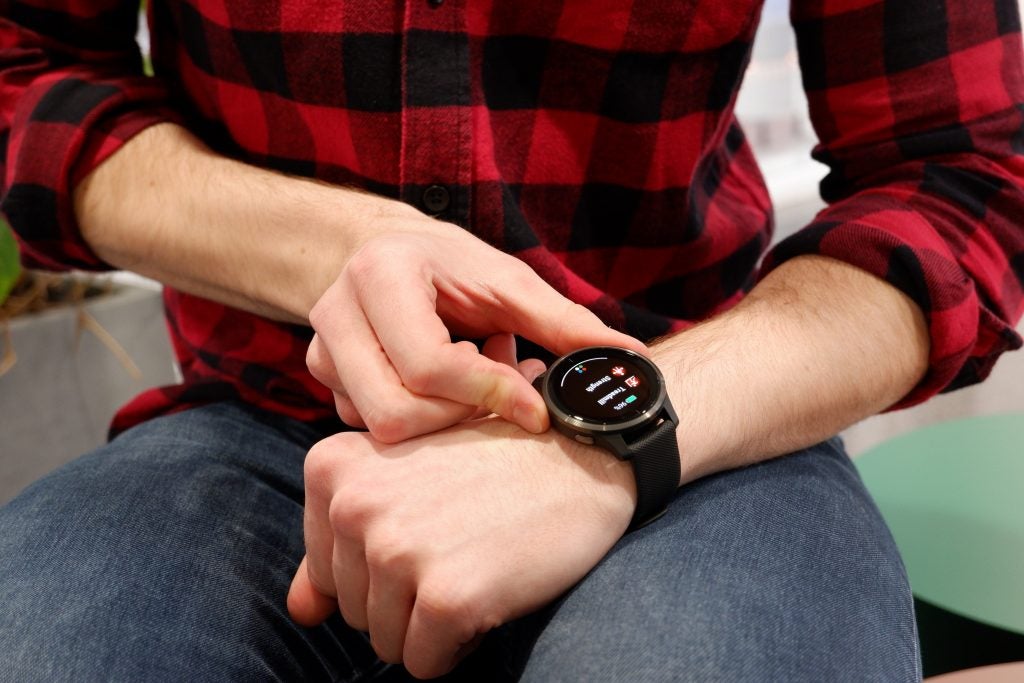Garmin Venu Review
Garmin Venu Review
The first Garmin to feature an AMOLED display

Verdict
The Venu’s steep asking price is hard to ignore; it's likely be a better purchase for some once the price drops. However, if you’re a fitness buff who needs a stellar workout companion that can also double as a stylish timepiece, then the Garmin Venu is for you.
Pros
- Best-in-class fitness tracking
- Up to 5-day battery life
- Bright AMOLED display
Cons
- High asking price
- Too similar to the Vivoactive 4
Key Specifications
- Review Price: £329.99
- Garmin Pay
- Offline music storage
- Corning Gorilla Glass 3
- 390 x 390 AMOLED display
- 5-ATM water-resistance
- HRT sensor
- Pulse Ox tracking
- Untethered GPS
What is the Garmin Venu?
The first entry in what will presumably be a continuing line of smartwatches from Garmin, the Garmin Venu is the company’s first smartwatch to feature an AMOLED screen.
By finally bringing a long-awaited AMOLED display to its arsenal of features, Garmin seems poised to take the Samsung Galaxy Watch Active head-on. The question on our minds then – as I’m sure will be the case for consumers – is the Garmin Venu a worthy purchase over its competitors?
As an additional consideration, given that the Garmin Venu is listed at £329.99, can the price hike be justified against Garmin’s own lineup of fitness trackers and smartwatches, including the recently released yet undeniably similar Garmin Vivoactive 4 (£259.99)?
Garmin Venu design – Perfect for the gym, or a night out
With each new entry in the Vivoactive series, Garmin has been making subtle changes to an already clean design. Its intention has been to make a sports watch that can be worn out and about at a variety of functions. The Garmin Venu continues this trend to a fault – if you were to place the new Vivoactive 4 beside the Venu, you’d be hard-pressed to notice any immediate differences.
Related: Best fitness trackers 2019

Encased in a fibre-reinforced polymer and packing a polymer rear cover, the Venu’s veneer may look smooth to the touch (and it is), but it feels ready to tackle any major bumps or scrapes that stand in its path. In keeping with the trend of being robust yet stylish, the watch’s bezel comprises stainless steel, and yet the textured pattern carved into it prevents it from being jarring to the overall design. It blends in with the textured grip of the Venu’s silicone watch strap perfectly.
Speaking of which, that very same watch strap packs a tough exterior, but it couldn’t be more comfortable. The single prong strap is easily adjusted and I didn’t encounter any issues with the free loop falling out of its intended place. In fact, clocking in at just 46.3g, the Venu strides that tricky tightrope of feeling substantial, without ever being clumsy or heavy on your wrist.
All of this combines to make the Garmin Venu a suitable smartwatch for a trip to the gym as well as on a night out – a crucial win given that, in order to get the most out of the device, Garmin expects you to wear it at all times.
Following on from the Vivoactive 3, Garmin appears to have realised that having just one physical button for interacting outside of the touchscreen just simply wasn’t enough, and I’m inclined to agree. The Venu (and the Vivoactive 4) now has two physical buttons, found on the north-east and south-east sections of the watch.
It’s also worth noting that Garmin’s four-pronged charging cable – which plugs directly into the back of some of its watches – has made a return with the Venu. If you’re not familiar with Garmin’s tech then you might find yourself wondering why the company hasn’t adopted wireless charging like most other smartwatches on the market. In my experience, however, having that physical entry point for the charging cable results in far fewer accidental disconnections.
Garmin Venu screen – OLED all the way
When initially running through the specs on the Venu, I was underwhelmed to realise that the only major difference between it and the Vivoactive 4 (which retails at £70 cheaper than the Venu) was the inclusion of an AMOLED display.
Don’t get me wrong, I like a good AMOLED screen as much as the next guy, but having just reviewed the Honor Band 5 fitness tracker, which has an AMOLED display and an asking price of just £29.99, I found myself wondering if the price hike was a worthwhile investment. That all changed as soon as I saw the two watches side by side.
I was never a major fan of Garmin’s low-energy, memory-in-pixel displays, but I could at least concede that they were a necessary evil in order to prolong battery life. In 2019, however, and when compared against the bright AMOLED panel of the Venu, the Vivoactive 4’s display looked like something akin to a calculator. My reaction was about the same as when anyone from Gen Z sees a cassette tape for the first time.
By having that 390 x 390-pixel display, it feels as though Garmin is finally taking a much-needed step in bringing the design of its wearables closer what’s on offer from the likes of Samsung and Fossil.
Thanks to the brightness levels that can be achieved via AMOLED, the Venu’s screen can easily be read in direct sunlight – handy for those outdoor runs. And yet, despite how great it looks, there’s a niggling part of my brain that just can’t help but wonder if the upgraded display is entirely worth forking out an additional £70.

These concerns come at a time when it’s easy to find the original Samsung Galaxy Watch Active for below £200n. Heck, even the recently released Samsug Galaxy Watch Active 2 comes in at £269 and £289 for the 40mm and 44mm models respectively.
If you have money to burn, then I can easily recommend opting for the Venu over the Vivoactive 4 – but for everyone else, it might be worth holding off until there’s a price drop.
Garmin Venu performance and features – Ticks the boxes
It might have fitness at the centre of its design, but the Venu is still very much a modern smartwatch, with all the bells and whistles you’d expect to find alongside.
Flip the device over and you’ll see the expected heart rate sensor, which – as you’d expect from a Garmin watch – offers brilliantly precise results. This time, though, the sensor does far more than just track you heartbeat.
With the Venu on your wrist, you can also monitor your SpO2 levels (labelled Pulse Ox here). Perfect if hiking or mountain climbing is your favourite form of exercise. Your stress levels are also monitored, through a combination of your heart rate and respiration levels. This is a fantastic feature, cleverly suggesting that you take a quick deep-breathing session in order to calm yourself down. It also gave me an outside perspective on some of my bad habits.
For instance, the Venu alerted me to high-stress levels after having two strong coffees in the same hour. Similarly, the high-stress alert would always pop up about half-way through a meeting, meaning I should probably spend more time practising my presentation skills – or at least going over my notes more thoroughly.
It’s just a shame, then, that that same level of precision hasn’t quite been carried across to the “body battery” feature.
On paper, the concept of the body battery seems ingenious. Taking in all the aforementioned information into account, the Venu is able to calculate how much energy you have left in the tank (out of a total 100). For people who exercise regularly, knowing when to schedule a proper rest day is essential, and is exactly the reason professional fitness trackers such as the Whoop 3.0 are growing in popularity. In practice, however, the feature doesn’t quite stick the landing.
After a decent night’s sleep, I noticed that my body battery had barely increased, with the app indicating that I should be feeling a lot worse than I actually was. My concern is that, until the kinks are ironed out, people might believe in their body battery levels wholeheartedly, and that any inaccurate results might send them hurtling towards the nearest source of caffeine, even if they don’t need it.

Contactless payment is available via Garmin Pay, but I was disappointed to see that only six banks are currently supported in the UK. The two most popular present are Santander and Starling Bank, so if you shop through the likes of Monzo, HSBC or NatWest, then you’re straight out of luck.
On a more positive note, Garmin has made greater strides in expanding its offline music capabilities to more streaming services than its competitors. Spotify, Deezer and Amazon Music are all compatible here, which is a breath of fresh air compared to wearOS’s insistence to lock you into a Play Music subscription if you want to take your tunes with you but leave your phone at home.
You’ll also be happy to know that, where sheer speed is concerned, the Garmin Venu is one of the fastest smartwatches I’ve had the pleasure of testing. Menu navigation is smooth and I never recorded any slowdown during intensive use. Even on the days when I through everything I possibly could at it, the Venu was more than happy to keep up the pace.
Garmin Venu fitness tracking – Excellent across the board
It’s no secret by now that when it comes to tracking workouts, Garmin absolutely wipes the floor with the competition, and the Venu is no exception. For the wealth of data offered up to the user, there really isn’t anything quite like it. Nevertheless, there’s still room for improvement when it comes tracking reps, particularly during strength exercises.
In my current bid to train for a 10k run in the blistering December cold, the Venu’s untethered GPS tracking has been a huge help. Following several lunchtime runs throughout the Isle of Dogs, the Venu was able to present a faultless map of my trajectory.
Accurate GPS is just the icing on the cake, however; I could also see the precise weather conditions at that time of day, detailed graphs of my pace and heart rate, and so much more. As an added bonus, any new achievements earned during the run will show up on your wrist as soon as you’ve logged the activity, giving you a well-timed confidence boost.
A debate has long since raged as to whether or not fitness trackers could genuinely rule out the need for personal trainers, and while I’m loathe to ring the death chimes of an entire profession, the Venu’s on-screen demonstrations are a game-changer.
Hands up if you’ve had this problem – you’ve just memorised a new workout routine on YouTube, only to forget one of the exercises as soon as you get to the gym. It’s beyond frustrating. With the Venu in tow, though, all you need to do is check your upcoming workout, tap on the exercise you’ve forgotten and a little watch-sized man will show you the exercise. It’s also a great feature if you just feel as though you haven’t quite nailed the required technique and need a quick refresher.

It sounds like the Venu’s fitness tracking capabilities are perfect, and for some exercises they certainly are. However, I found the watch’s rep tracking to fluctuate wildly. A set of ab crunches would be recorded correctly, but a simple reach for the barbell – prior to a barbell biceps curl – would be registered as two reps, and some curls wouldn’t be recorded at all.
Luckily, you’re given the option to manually input the number of completed reps at the end of a set, but it left me dreaming of the day when everything could be recorded automatically and correctly.
Garmin Venu battery – Days, rather than “a day”
It doesn’t matter how much I enjoy using a smartwatch, a poor battery is a deal breaker for me. I think I speak for everyone when I say that we only have so much attention to spend towards ensuring our smartphones are topped up daily – any smartwatch asking the same better get out of my sight.
Garmin’s devices have always had a knack for boasting superb battery life, but now the Venu is far more easily compared with modern smartwatches – and not just sports watches; its up to five-day battery life should put the competition to shame. Even the Fossil Gen 5, which brought in a bunch of new battery modes to see it last over several days, still can’t compare.
When worn as a 24-hour device, tracking my heart rate, numerous exercises (including the use of GPS and music streaming), I was able to get around four days of use out of the Venu – which is still fantastic by smartwatch standards. I’d have no doubt that a more conservative user could get the battery stretch for five days.
Plus, if you have a marathon coming up, Garmin assures us that you’ll be able to get six hours of battery with the untethered GPS and offline music streaming in constant use.
Should I buy the Garmin Venu?
With the release of the Apple Watch 5 and the Samsung Galaxy Watch Active 2, 2019 seems to be the year of incremental updates to smartwatches, and the Garmin Venu is no exception.
With that said, the device is built upon Garmin’s unbeatable fitness tracking software, which is finally brought into the mainstream with the inclusion of a much-needed AMOLED display.


